
Mud wrestling might sound like fun but it’s always a safe option to try to avoid the sticky, gloopy stuff if you can. Why? Because mud is no good for your 4x4; it can be damaging to paintwork, to mechanical components and to your vehicle’s interior.
And it’s not just your vehicle that can cop damage when driving through mud; aggressive mud-terrain tyres spinning furiously while trying to gain purchase in mud can cause severe damage to roads and tracks, making it more difficult for following vehicles to get through, even after everything has dried up.
As well as vehicle and track damage, if things really don’t go to plan in mud, you could end up stuck … and getting out of sticky, gloopy mud can sometimes be extremely difficult.
So, the next time you’re driving along a track and you’re tempted to drive through a big mud hole, a better option would be to look for a way around it. Of course, sometimes there won’t be an alternative route, or you just might not be able to help yourself, in which case here’s what you’ll need to do …
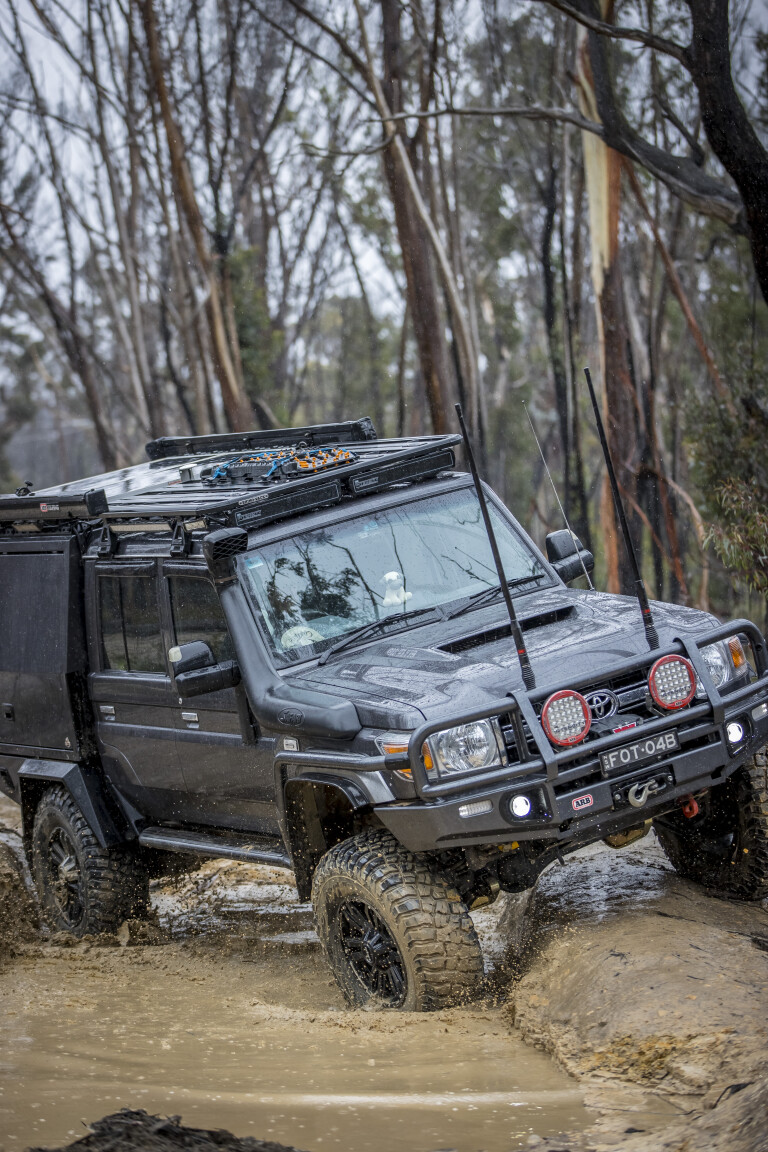
PREP YOUR VEHICLE
Your 4x4’s tyres are critical when it comes to maintaining forward progress on any off-road surface, and mud is no exception. When it comes to driving in mud, aptly named mud-terrain tyres are the best choice. They have wide-open tread blocks that allow them to gain traction more easily in slippery mud, and they are also more able to clear mud when spinning than tyres with ‘tighter’ tread patterns that can trap and hold on to mud. Some mud-terrain tyres also have tread blocks that continue over the tread face and on to the sidewalls (sometimes called side-biters) for additional traction in the slippery stuff.
Mud-terrain tyres aren’t for everyone however, as there are several compromises compared to less-aggressive all-terrain or highway-terrain tyres. These include less on-road grip, increased on-road noise and faster tyre wear. If you’re not willing to accept these compromises, all-terrain tyres are the next best choice for mud driving, but even highway-terrain tyres can still work well in mud if the correct tyre pressures are set … but more on that later.
The next thing to consider for mud driving is your vehicle’s ground clearance. As mud is viscous, it gets pushed around by spinning tyres, often resulting in deep wheel tracks as vehicles pass through muddy sections. If your 4x4’s tyres fall into these deep wheel tracks, you can soon run out of ground clearance and find yourself ‘hung-up’ on the crown (the raised middle bit) of a road or track. Obviously, the more ground clearance you have, the less chance of getting stuck.
In most states and territories, you can legally increase your vehicle’s ground clearance by 75mm (three inches) by combining larger diameter tyres (+25mm) and a raised suspension system (+50mm).* You can go even further in some states/territories if you have engineering approval … or a vehicle that has been modified and registered by a second-stage manufacturer.
Other vehicle equipment that is beneficial for mud driving includes the fitment of front and rear differential locks, a quality snorkel and extended breathers for your vehicle’s differentials, gearbox and transfer case.
You’ll also want to make sure your vehicle is equipped with rated recovery points front and rear, and that you are carrying appropriate recovery gear in case you get stuck.
*Check with your state authorities regarding the legalities of raising the height of your vehicle.
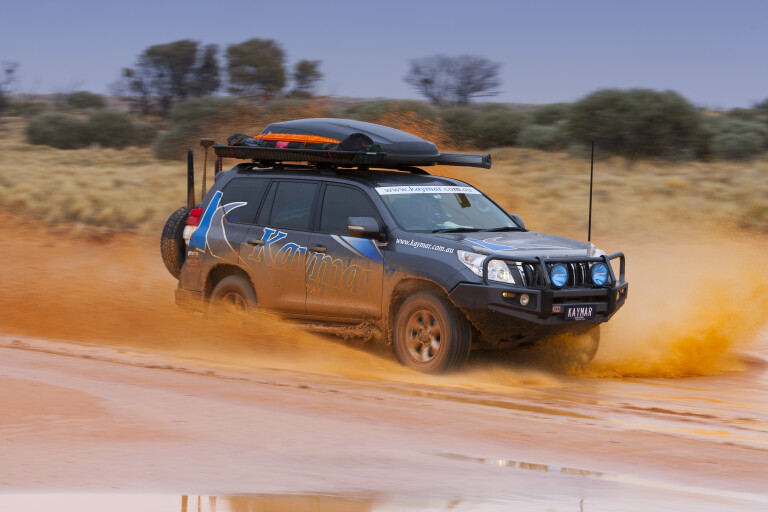
BEFORE YOU DIVE IN
If you’re driving along a bush track and you’re confronted by a big mud hole, you’ll need to find out what’s lurking beneath the surface, and the best way to do this is with a big stick … unless of course, you don’t mind getting dirty and wading through it on foot. If you choose the latter option, make sure you’re wearing sturdy footwear.
With a stick, walk along each side of the mud hole, gauging the depth with your stick and feeling for the consistency of the base to see if it’s firm or sloppy goop. Also try to judge how high the crown is to make sure you have enough ground clearance to make it through, and poke the stick around to see if there are any obstacles such as large rocks, branches or even parts that may have broken off vehicles; you might need to build up some speed to get through a mud hole and the last thing you want to do is hit a hard, submerged object.
Also check to see if there are any rocks or tree roots protruding from the sides of the mud hole that could cause tyre damage.
A thorough check of a mud hole also gives your vehicle time to cool down. If you drop hot mechanical components straight into icy cold, muddy water, they will contract when cooled and try to suck the muck past worn seals on your gearbox, transfer case and diffs.
If you’re on an outback road and you happen across a muddy section, drop your speed enough so that you’ll have plenty of time to choose the best route through the mud, or around it; make the wrong decision and you could soon find yourself up to your axles in gooey, sticky vehicle-sucking mud.
Mud can even be problematic on sealed outback roads. If there’s been water about and you need to pull off to the side of the road to avoid oncoming vehicles, or you’re just pulling up for a cuppa, beware that it can still be boggy on the verges well after the rain has stopped.
In desert country, sticky mud will often be present just below the surface of seemingly hard, crusty saltpans, and if your tyres break through the top layer, you could soon find yourself stuck. If you can see tracks ahead of you, and they look like they exit out the other side, drive in these tracks if you think you’ll have enough ground clearance, as the base will have been compacted by the preceding vehicle(s).
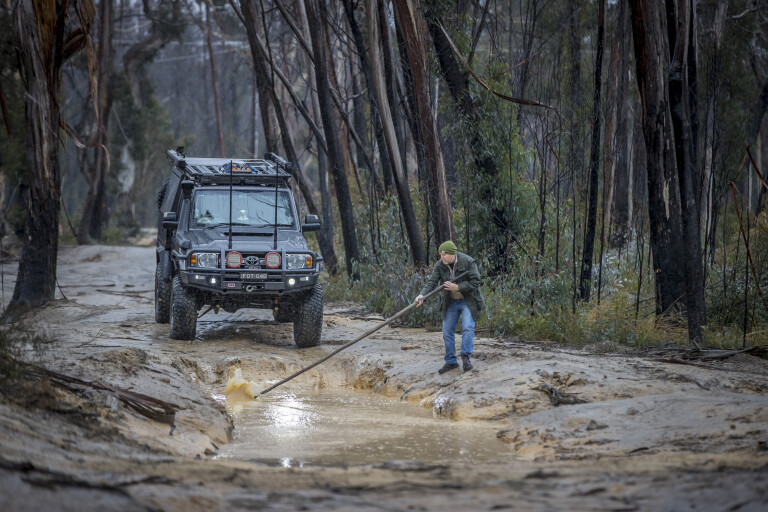
GETTING SET
Like most off-road driving situations, your vehicle will perform at its best if you’re running the appropriate tyre pressures. Lowering the tyre pressures for mud driving extends the footprint of each tyre, and allows the tyres to conform to uneven surfaces, allowing them the best chance to gain purchase, especially when the mud has a soft base.
How low you drop tyre pressures depends on your vehicle and the load you are carrying, but if you normally run around 35psi on the road, for example, you should be able to safely go as low as 22psi for mud driving. Just bear in mind that when running low pressures there will be an increased risk of rolling a tyre off a rim, or overheating the tyres, so try not to make any sudden direction chances and don’t drive too fast.
There’s always the potential to get stuck in mud, so before you dive in, make sure you have an escape plan. If you’re travelling with other vehicles, have a snatch strap ready in case you need someone to help you out. If you’re travelling solo, make sure your shovel and recovery boards are easy to get to in case you need them, and if you have a winch, make sure your rigging (winch extension strap, tree-trunk protector, shackles, snatch blocks/rings etc.) is handy, and that you have something to winch off.
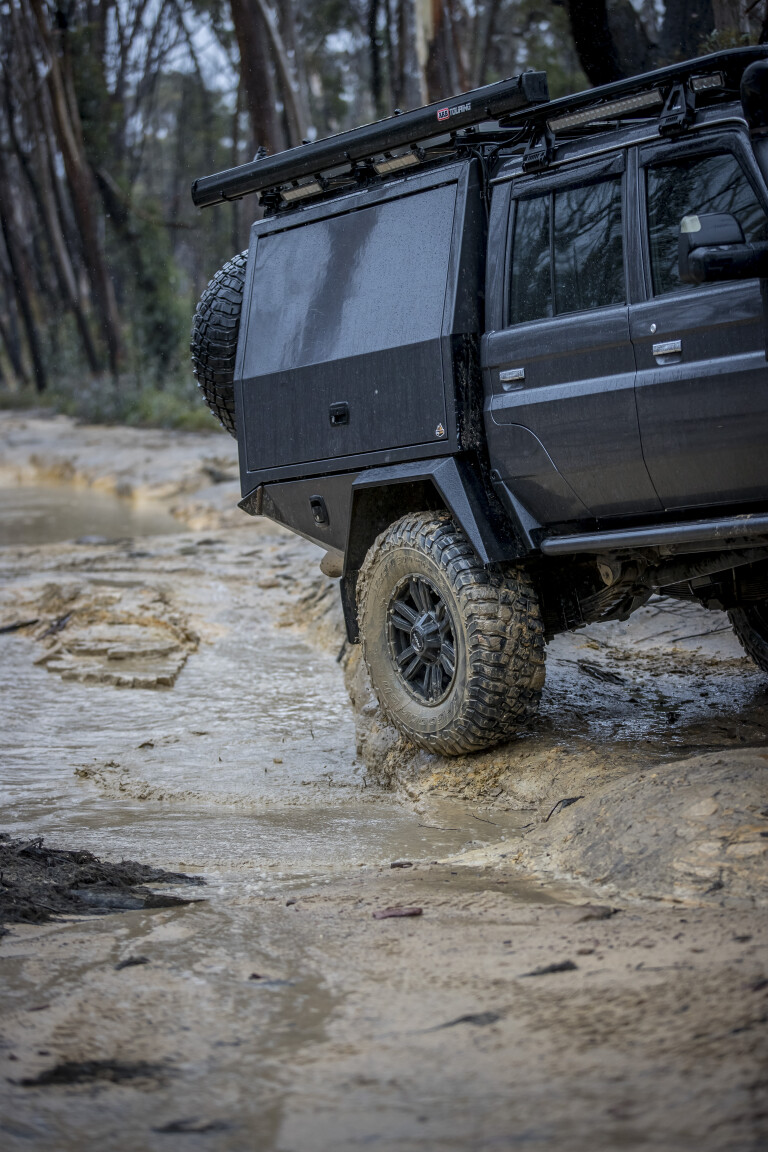
READY TO ROLL …
You're now ready to tackle the mud, so lock your hubs if fitted, make sure your vehicle is in 4x4, lock the centre diff if fitted, and select the gear that you think will result in enough speed and momentum to get you through the muddy section. Low-range second or third is often a safe bet, but it will depend on your vehicle’s overall gearing and the mud you’re faced with; the key is to maintain enough speed to get you through to the other side, but not so much speed that you might damage your vehicle.
If you’re 4x4 has selectable drive modes, select the appropriate one for mud, which on many vehicles is labelled ‘mud and ruts’. This will tailor throttle response, automatic gear shifts and the behaviour of the traction-control system to suit the conditions. If you have diff locks on rear and/or front axles, lock them before driving into the mud, but be wary that locking your front diff will make it more difficult to steer the vehicle.
When driving through mud, keep engine revs up and try to avoid gear changes; in manual transmission vehicles, disengaging the clutch in mud can result in you losing momentum and quickly becoming stuck – you need to keep those wheels turning!
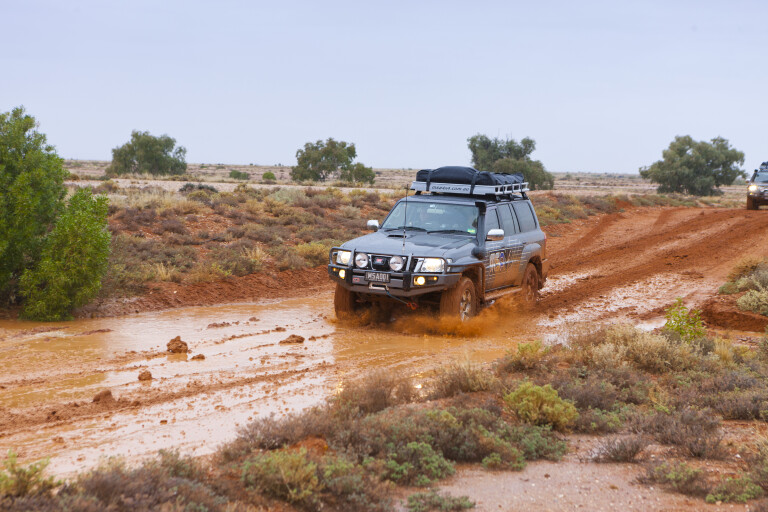
On the flipside, if you bury your wellie and your tyres start spinning furiously in mud, there’s a chance you could simply be digging yourself into the muck. If you start to lose traction, the trick is to find a happy medium between wheelspin and forward progress.
There is an upside to your wheels spinning, and that is the rotational forces will help to clear mud from the tread blocks so the tyres will have more chance of gaining purchase.
If you start losing momentum but the wheels are still spinning, another trick is to quickly turn the steering wheel back and forth. This action gives the front tyres a chance to bite into the sides of ruts, which with any luck will help to drag your vehicle through the mud. The side-biters on mud-terrain tyres assist when employing this technique.
You might have to straddle wheel tracks if they look too deep, but take care not to slide into the tracks.
Mud driving in hilly terrain can be fraught with danger, especially on steep descents. In these conditions you’ll want to rely on your vehicle’s low-range gearing as much as possible to keep speed in check instead of the brake pedal. On older vehicles without ABS, if you jump on the brakes and the front wheels lock up you will lose steering control. If this happens, dropping into existing wheel tracks can help point you in the right direction. On vehicles equipped with ABS, relying on the brakes can result in excessive braking distances. Slow and steady is the best technique for muddy descents.
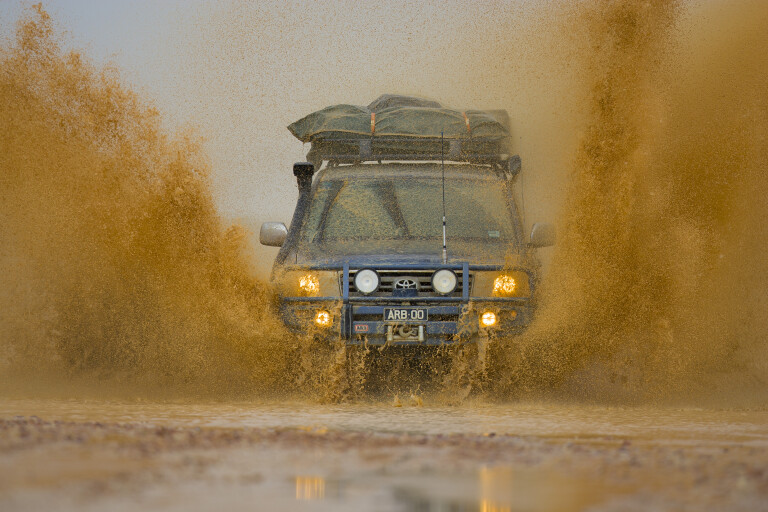
WHAT TO DO IF YOU GET STUCK
The first thing to do if you get stuck in the mud is to try and reverse out. Often the reason you become stuck is because mud builds up in front of the tyres, so if you can back up a bit and have another go with a bit more gusto you might just be able to make it out of your predicament.
If you can’t move in either direction, chances are much mud has built up under your vehicle, so you’ll need to grab your shovel and start clearing the mud away. Start by shovelling away the mud on front of the tyres, and then underneath your rig. Now could also be a good time to use your recovery boards. Wedge them in front of the front tyres, select low-range first and try to gently drive on to the recovery tracks. Once up and on to the tracks, try to build up speed and maintain momentum until you’ve reached firmer ground. This can take several attempts.
If you’re fortunate enough to be travelling with other vehicles, a tug with a snatch strap or kinetic recovery rope is one of the fastest ways to recover a vehicle from mud, but make sure you know what you’re doing, and always follow proper safety procedures.
If you need to winch yourself out of the mud, make sure you find a solid anchor point and use a double-line pull if you’re really stuck. Before you start winching, clear away as much mud as possible from in front of the tyres and under the vehicle.
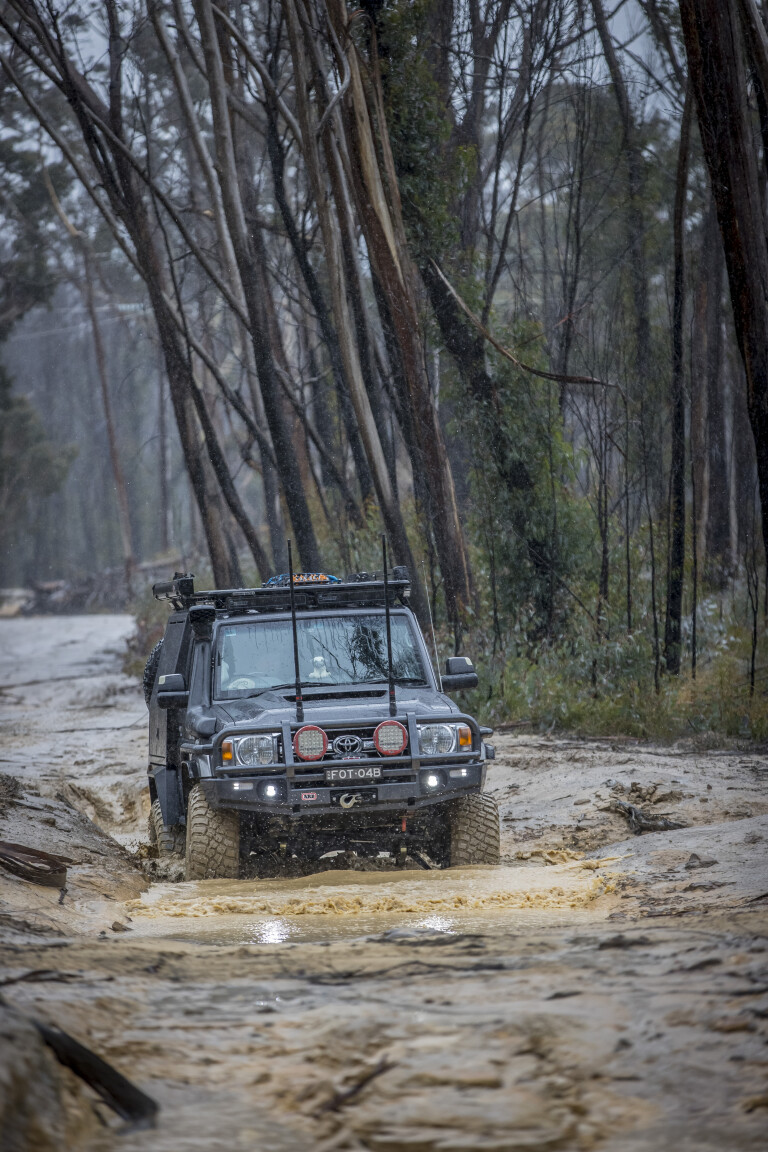
BACK ON DRY LAND
Once you’re out of the mud, have a good look over your vehicle to check for damage. When reinflating tyres, have a good look to make sure they are not damaged and check that mud hasn’t worked its way in-between the tyres and the wheels. Also have a good look inside the wheel rims to ensure there aren’t big clumps of mud in there that could throw them out of balance.
Make sure your mudflaps and wheel-arch flares are all in place and secured, and that the licence plates are still attached and not covered in mud. Also make sure your headlights, tail-lights and indicators are clean, as well as your windscreen, windows and mirrors.
Once you get home, clean your vehicle as soon as you can. The abrasive nature of dried out mud is no good for your vehicle’s paint, chrome or plastics. Give your rig a good clean underneath too, as mud can be hell on components such as clutches, wheel bearings and CV joints. Also have a good look in chassis rails for built-up mud that could result in corrosion issues down the track, and hose away any mud between the body and chassis, and around suspension components and fuel tanks.
Lift the bonnet and make sure the radiator, alternator and other components aren’t caked in mud. If they are, thoroughly clean them to prevent engine overheating or electrical failures.
If you’ve been driving in deep mud holes, you should also check the engine, gearbox and diff oils to make sure no contaminants have worked their way into these mechanical components.
As I said at the start of this guide, it’s always a good option to try to avoid mud rather than drive through it if you can …
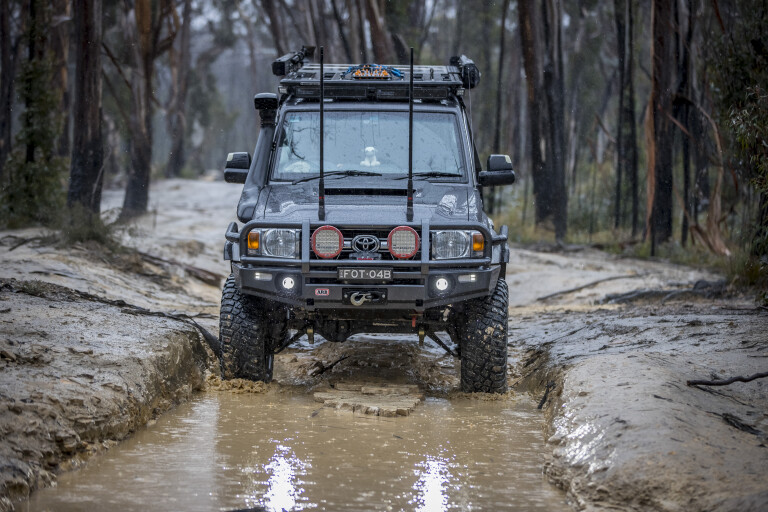
DO
1. Try to avoid it if you can
2. Lower tyre pressures
3. Engage 4x4/select mud mode/lock hubs and diffs
4. Maintain momentum
5. Carry recovery gear and have a plan
DON’T
1. Drive in mud holes without checking depth first
2. Lose momentum by changing gears in deep mud
3. Brake too hard on steep, muddy descents
4. Pull off the road too far in flat country
5. Leave your 4x4 caked in mud

COMMENTS